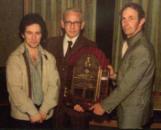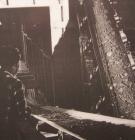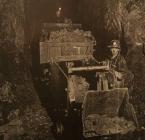2
In 1960, the provincial government used the Undeveloped Mineral Areas Act to reclaim fee-simple grants covering Rambler deposits. The property was then leased to M.J. Boylen, who in 1961 leased it to Consolidated Rambler Mines.The original Rambler deposits were staked in 1904 by Enos England and Thomas Wells of Little Bay, the former of whom discovered the orebody.
A series of prospects, called "The Rambler", lie approximately 6 mines east of Baie Verte. The first discovery was made in 1905 by Enos England. His early work included the sinking of a 65 foot shaft and the development of several short drifts. This work was discontinued because the copper content of the pyritized schists was low.
In 1939 development work included mapping, drilling, and geophysical surveys. This work was conducted by the Geological Survey of Newfoundland, Rambler Mines Ltd., Siscol Gold Mines Ltd., and Falconbridge Nickel Mines Ltd.
In the immediate area quartz veins carry erratic value in gold along with scattered copper, lead and zinc mineralization. Principal values were in copper and zinc with gold as a valued by-products.
The Rambler area is a favourable area for exploration. The rock is easily replaced chloride schists and altered vocanice which lie in a reentrant in a batholithic mas of granitic rocks. It would seem almost certain the Rambler area will again support an active mine.
4
A pic of the conveyor shaft from the crusher to the Mill. The big wheel is a spare Sheave wheel which belongs in the "head frame" which can be seen in the far left. It was part of an elevator system that was used to transport ore from the shaft to the extraction facilities as well as men down into the shaft for work, it was removed for repairs and placed on a platform in front of the coveyor.6
The crusher room of Rambler Copper Mine. Mr. Sidney Sacrey of Pacquet monitors ore as it is crushed and sent to the fine ore bins in the mill for extraction and processing.8
Underground operations at Rambler Copper Mines. Pictured is an air powered Emco 21 mucking machine and a batter powered trammer with a 72 cubic foot car. It was the job of the mucking machine to enter the tunnel on rail tracks after a blast to remove ore and dump it in the mine car or the trammer who transported it to the main shaft where the skip, or bucket, elevator would take it to the surface and dump it in the ore bins for further processing. Two men were required to operate this system, the bucket operator on the mucking machine, Jim Haas, seen in front, and the trammer driver, Bill King, seen in the back.11
A picture of the primary mine site at Rambler. The facilities from right to left are as follows. The hoist room, this building contained the motor which powered the skip, or bucket, elevator in the head frame. The head frame, this was one of three frames at different sites, one for each shaft. This structure contained the skip elevator, which was used to remove ore from shaft to the extraction facilities and to lower men into the shaft. Ore then dropped from the skips into an ore storage bin before moving into the crusher room where the ore was then crushed. Once crushed, the ore goes into conveyor shaft which brings the ore to fine ore bins in the refining mill where a water based extraction process takes place called crush and floatation extraction. Then any waste materials are treated and pumped through a tailings pipe to a storage lake.12
Accepting John T Ryan award manager, John Grainger, and Safety supervisor, Gordon Bounds.1960
Rambler Mines, NL







